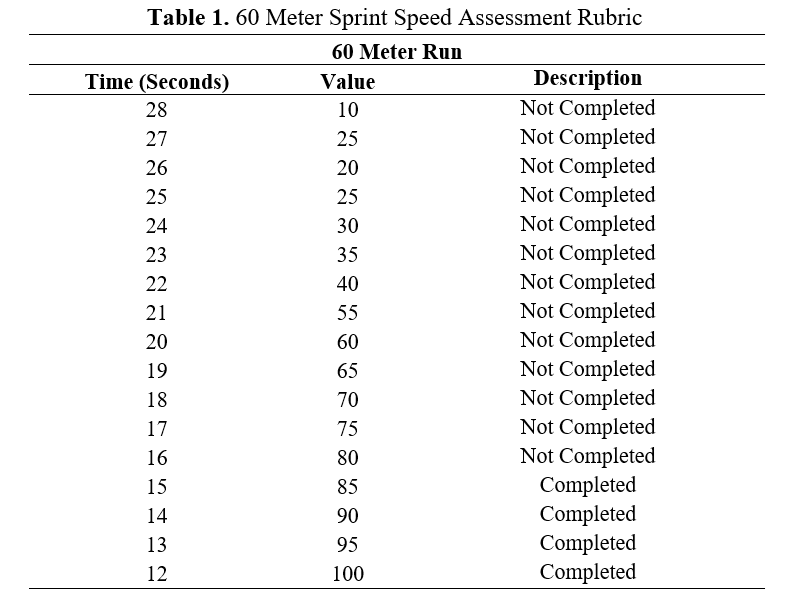Athletics Formula 1 Games for Elementary School Students: Learning Achievement for 60 Meter Running Speed
DOI:
https://doi.org/10.51574/ijrer.v4i3.3069Keywords:
Elementary School, Kids Athletics, Formula 1, Speed, 60 Meter RunAbstract
This study aims to determine whether the implementation of the Kids Athletics Formula 1 game leads to an increase in 60-meter running speed among students in public elementary schools. The study also aims to develop innovative methods for enjoyable athletic learning for elementary school students. We conducted the study in two cycles using the Classroom Action Research method (planning, implementing actions, observation, and reflection). The subjects of the study were 18 grade VI students at public elementary school 7 Salatungo. The instrument used was a 60-meter running speed test with the Learning Objective Completion Criteria set at 80. The results of the study showed a significant increase in students' 60-meter running ability after the implementation of the Kids Athletics Formula 1 game. In the pre-cycle, the average student score was only 62 with a completion percentage of 0% (no students completed). In cycle I, the average score increased to 73 with a completion percentage of 22% (4 students completed). In cycle II, after the improvement of the learning method, the average score increased to 82 with a completion percentage of 100% (all 18 students completed the Learning Objective Achievement Criteria). The implementation of the Kids Athletics Formula 1 game has proven effective in increasing the 60-meter running speed of grade VI students at public elementary school 7 Salatungo. A fun learning approach through games can increase student enthusiasm and significantly improve their athletic skills.
References
Aji, S., & Winarno, M. E. (2021). Pengembangan instrumen penilaian keterampilan gerak dasar atletik siswa sekolah dasar. Jurnal Keolahragaan, 9(1), 111-123. https://doi.org/10.21831/jk.v9i1.39265
Ames, C. (2020). Competition, cooperation, and the development of social motivation in educational settings: A 25-year retrospective and analysis. Educational Psychology Review, 32(3), 733-758. https://doi.org/10.1007/s10648-020-09546-w
Burhaein, E., Phytanza, D. T. P., & Demirci, N. (2020). The development and validation of a revised Perceived Motor Competence Scale for elementary school children. International Journal of Human Movement and Sports Sciences, 8(5), 211-218. https://doi.org/10.13189/saj.2020.080605
Creswell, J. W., & Creswell, J. D. (2017). Research design: Qualitative, quantitative, and mixed methods approaches (6th ed.). SAGE Publications.
Erwin, H. E., Beighle, A., Castelli, D. M., & Centeio, E. (2023). The impact of regular physical activity on academic achievement in elementary school children. Journal of School Health, 93(4), 325-337. https://doi.org/10.1111/josh.13272
Friend, M., & Cook, L. (2020). Interactions: Collaboration skills for school professionals (9th ed.). Pearson Education. https://doi.org/10.4324/9780429441158
Gozzoli, C., Locatelli, E., Massin, D., & Wangemann, B. (2022). IAAF Kids' Athletics: A practical guide (3rd ed.). World Athletics. https://doi.org/10.5281/zenodo.3764153
Hanief, Y. N., Supriyadi, S., & Maulana, H. (2020). Implementasi permainan Kids Athletics dalam meningkatkan kebugaran jasmani siswa sekolah dasar. Sport Science and Health, 2(9), 416-424. https://doi.org/10.17977/um062v2i9p416-424
Hattie, J., & Timperley, H. (2017). The power of feedback revisited: A meta-analysis of educational feedback research. Review of Educational Research, 87(6), 1232-1274. https://doi.org/10.3102/0034654317723617
Hidayat, A., & Pratama, R. (2022). Pengaruh latihan Kids Athletics Formula 1 terhadap peningkatan kecepatan lari 60 meter pada siswa sekolah dasar. Jurnal SPORTIF: Jurnal Penelitian Pembelajaran, 8(1), 126-138. https://doi.org/10.29407/js_unpgri.v8i1.17232
Jamalong, A., & Syam, A. (2021). The effect of running play on improving the speed and agility of elementary school students. Journal of Physical Education and Sport, 21(2), 1149-1154. https://doi.org/10.7752/jpes.2021.s2144
Juniarta, A. T., & Siswantoyo, M. (2021). Pengembangan model latihan kecepatan berbasis permainan untuk atlet atletik usia dini. Jurnal Keolahragaan, 9(2), 293-306. https://doi.org/10.21831/jk.v9i2.40867
Karwasz, G. P., & Wyborska, K. (2023). How constructivist environment changes perception of learning: Physics is fun. Education Sciences, 13(2), 195. https://doi.org/10.3390/educsci13020195
Kurniawan, W., & Setyawan, D. A. (2021). Circuit training model for improving the physical fitness of elementary school students: A systematic review. Journal of Teaching Physical Education in Elementary School, 5(1), 41-50. https://doi.org/10.17509/tegar.v5i1.39512
Lee, J. J., Clarke, C. L., Carson, M. N., & Yang, S. C. (2018). How do Korean nursing students build knowledge? A constructivist grounded theory study. BMJ open, 8(7), e022050. https://doi.org/10.1136/bmjopen-2018-022050
Lubis, M. R., & Permana, D. F. W. (2023). Analisis kemampuan motorik kasar siswa sekolah dasar melalui pendekatan bermain. Jurnal Pendidikan Jasmani dan Adaptif, 6(1), 30-41. https://doi.org/10.21009/jpja.v6i1.23517
Mertler, C. A. (2022). Action research: Improving schools and empowering educators (7th ed.). SAGE Publications. https://doi.org/10.4135/9781483396484
Morgan, P. J., Young, M. D., Barnes, A. T., Eather, N., Pollock, E. R., & Lubans, D. R. (2019). Engaging fathers to increase physical activity in girls: The "Dads And Daughters Exercising and Empowered" (DADEE) randomized controlled trial. Annals of Behavioral Medicine, 53(1), 39-52. https://doi.org/10.1093/abm/kay015
Nurkholis, N., & Weda, W. (2022). Implementasi Kids Athletics dalam pembelajaran pendidikan jasmani di sekolah dasar. Jurnal Ilmiah JARGARIA SPRINT, 4(1), 26-36. https://doi.org/10.30862/js.v4i1.233
Prasetyo, Y., & Sudarko, R. A. (2021). Pengembangan model latihan Kids Athletics untuk peningkatan multilateral siswa sekolah dasar. Journal of Sport and Exercise Science, 4(2), 92-103. https://doi.org/10.26740/jses.v4n2.p92-103
Prastyo, B. W., Sugiyanto, S., & Doewes, M. (2020). The effectiveness of traditional games-based development model for fundamental movement skills in elementary school students. International Journal of Multicultural and Multireligious Understanding, 7(10), 169-179. https://doi.org/10.18415/ijmmu.v7i10.2068
Pullen, B. J., Oliver, J. L., Lloyd, R. S., & Knight, C. J. (2020). The effects of strength and conditioning in physical education on athletic motor skill competencies and psychological attributes of secondary school children: A pilot study. Sports, 8(10), 138. https://doi.org/10.3390/sports8100138
Putra, K. P., & Suharjana, S. (2021). Pengembangan model permainan atletik Kids Athletics dalam pembelajaran pendidikan jasmani sekolah dasar. Jurnal Pendidikan Jasmani Indonesia, 17(1), 71-83. https://doi.org/10.21831/jpji.v17i1.39799
Rumini, R., & Sulistyorini, S. (2020). Pengembangan pembelajaran atletik berbasis permainan di sekolah dasar. Jendela Olahraga, 5(2), 90-99. https://doi.org/10.26877/jo.v5i2.6328
Saputra, N. E., & Ekawati, Y. N. (2021). Permainan tradisional sebagai upaya meningkatkan kemampuan dasar anak: Implementasi pada anak usia sekolah dasar. Jurnal Pendidikan Jasmani dan Olahraga, 6(1), 173-183. https://doi.org/10.17509/jpjo.v6i1.32564
Schunk, D. H. (2016). Learning theories: An educational perspective (8th ed.). Pearson Education. https://doi.org/10.1177/0017896912436869
Setiawan, A., Yudiana, Y., Rahmat, A., & Budi, D. R. (2020). Implementasi Kids Athletics berbasis tematik untuk meningkatkan keterampilan gerak dasar siswa sekolah dasar. TEGAR: Journal of Teaching Physical Education in Elementary School, 4(1), 7-14. https://doi.org/10.17509/tegar.v4i1.25758
Stringer, E. T. (2021). Action research (5th ed.). SAGE Publications. https://doi.org/10.4135/9781473921290
Suwardi., Saleh, M. S., & Arga. (2024). Keterampilan Kids Athletics Siswa UPTD SD Negeri 164 Barru Kecamatan Pujananting Kabupaten Barru. Journal Physical Health Recreation (JPHR), 4(2), 532-538.
Wentzel, K. R. (2018). Social relationships and motivation in middle school: The role of parents, teachers, and peers revisited. Journal of Educational Psychology, 110(3), 389-411. https://doi.org/10.1037/edu0000228
Wick, K., Leeger-Aschmann, C. S., Monn, N. D., Radtke, T., Ott, L. V., Rebholz, C. E., Cruz, S., Gerber, N., Schmutz, E. A., Puder, J. J., Munsch, S., Kakebeeke, T. H., Jenni, O. G., Granacher, U., & Kriemler, S. (2018). Interventions to promote fundamental movement skills in childcare and kindergarten: A systematic review and meta-analysis. Sports Medicine, 48(10), 2407-2424. https://doi.org/10.1007/s40279-018-0943-0
Widiastuti, W., & Hutapea, L. (2021). Pengaruh model pembelajaran Kids Athletics terhadap keterampilan gerak dasar lari siswa sekolah dasar. Jurnal SPORTIF: Jurnal Penelitian Pembelajaran, 7(2), 270-285. https://doi.org/10.29407/js_unpgri.v7i2.16321
Wormhoudt, R., Savelsbergh, G. J., Teunissen, J. W., & Davids, K. (2017). The athletic skills model: Optimizing talent development through movement education. Routledge.

Downloads
Published
How to Cite
Issue
Section
License
Copyright (c) 2025 Syamsul Hadi, Muh. Adnan Hudain, Ilham Kamaruddin, Ahmad Adil, Fahrizal Fahrizal

This work is licensed under a Creative Commons Attribution-ShareAlike 4.0 International License.









1.png)













